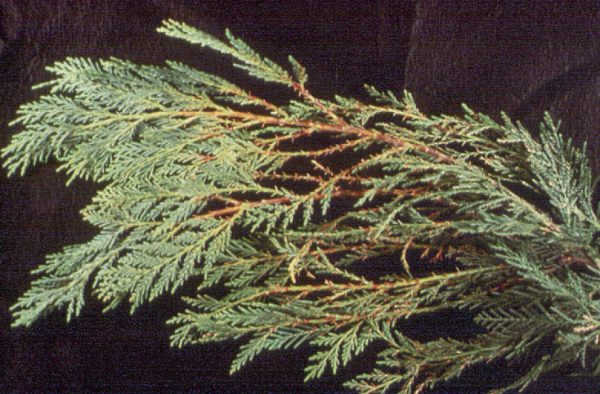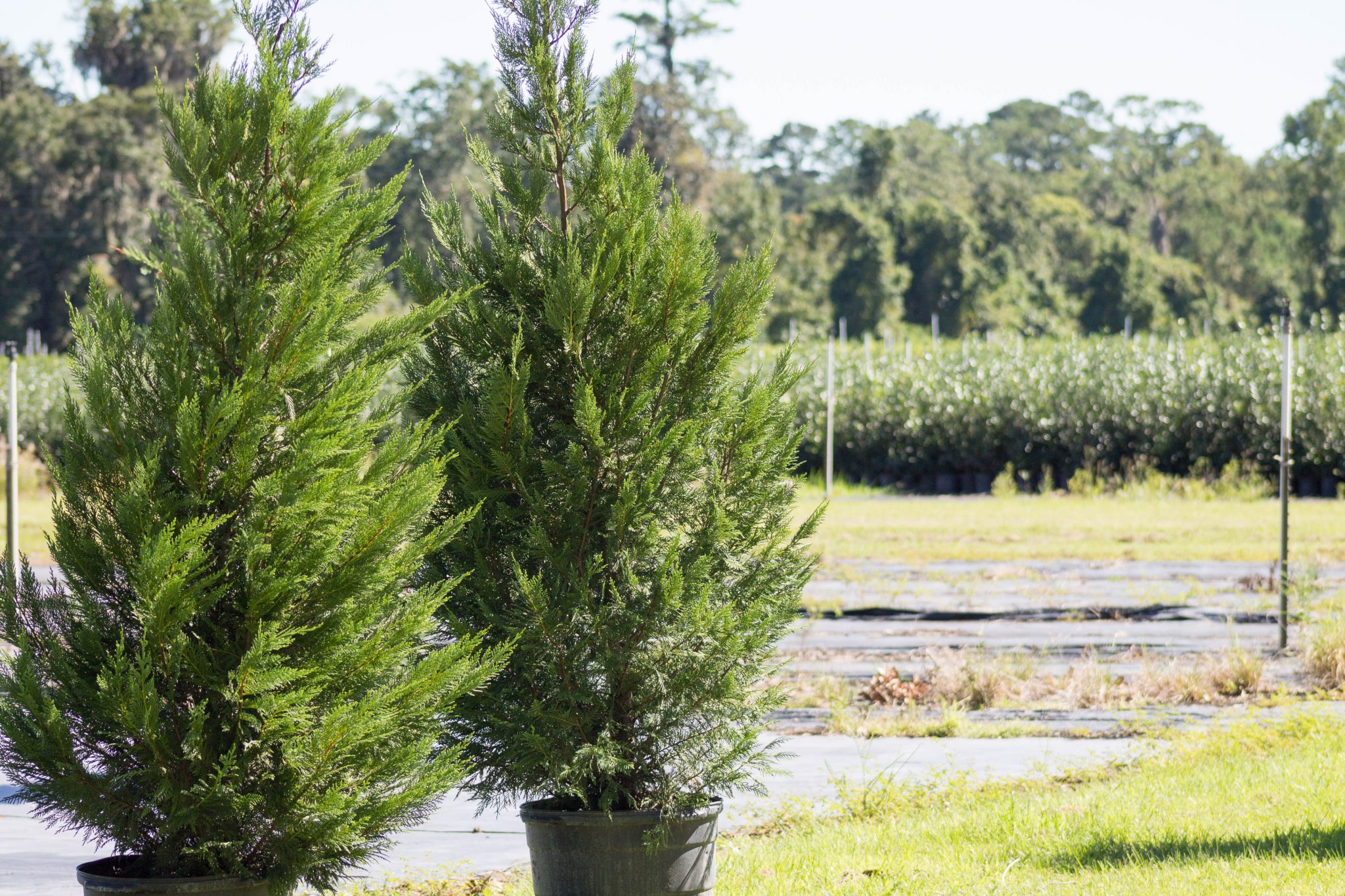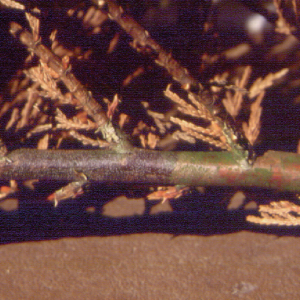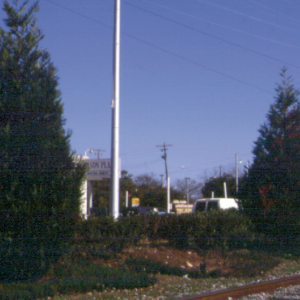Landscaping

Within the last decade, Leyland cypress has been widely used in residential and commercial landscapes across Alabama not only as a specimen tree, screen, or hedge, but also as a Christmas tree. Popularity of this tree, which is a hybrid of the Monterey cypress (Cupressus macrocarpa) and the Nootka falsecypress (Chamaecyparis nootkatensis), is due in large part to its graceful columnar to pyramidal shape, its attractive dark green foliage, and its rapid growth rate. Mature Leyland cypress may reach a height of 70 feet or more.
In its native England, Leyland cypress reportedly has suffered from relatively few damaging diseases. However, in recent years, several threats to the health and beauty of Leyland cypress have emerged in Alabama landscapes and on Christmas tree plantations. Leyland cypress is best adapted to fertile, moist, well-drained soils. Unfortunately, this tree is often planted on poorly drained sites where it is not well adapted. In addition, Leyland cypress, which is relatively shallowrooted, may be weakened when exposed to prolonged periods of drought during Alabama’s blistering-hot summers. Finally, poor planting and maintenance practices as well as extremely close plant spacing further increase plant stress and the risk of fungalincited canker and dieback diseases, including Seridium canker and Botryosphaeria, or Bot, canker.
Seridium Canker
Seridium canker was first described in the mid-20s on Monterey cypress in California. Within 20 years, a dieback and canker disease caused by the fungus Seridium cardinale devastated stands of this tree in the hot and dry Central Valley of California. During the same time frame, native stands of this tree along the cooler and wetter California central coast suffered little if any disease-related damage. In the mid-80s, Seridium canker was reported on Leyland cypress in California. Since then, this disease has emerged across the Southeast as a common and damaging disease in landscape plantings and on Christmas tree plantations. As was the case with Monterey cypress, disease development on Leyland cypress has been closely tied with hot, dry summer weather. Two other species of Seridium, S. unicornie and S. cupressi, are also known to cause canker diseases in juniper and cypress, but their importance is unknown.
Symptoms

Figure 1. Yellowed foliage on branch of Leyland cypress damaged by Seridium
canker. (Photo courtesy of L. Barnes, Texas A&M University.)
The most noticeable symptom of Seridium canker is yellowing or browning of the foliage on one or more top or lateral branches (Figure 1). This discoloration may appear at any time of the year but is most likely to be seen in the spring. Disease development often continues until a considerable portion of the tree is killed.
The causal fungus often invades Leyland cypress and other hosts through wounds on the twigs and branch bases. Girdling cankers form on the twigs, the scaffold branches, and the main trunk, and then the foliage dies. Lens-shaped cankers on the twigs and branches appear as gray, discolored areas on the bark. Resin often oozes from cracks on the surface of the cankers and flows down the diseased branches or tree trunk. Fruiting bodies of the causal fungus S. cardinale appear on the canker face as small black dots about the diameter of pencil lead.
Disease Cycle
The causal fungus S. cardinale overseasons in the landscape and nursery in cankers on diseased Leyland cypress. Other native and introduced evergreens may also be a source of this fungus. When the bark surface is moist, masses of spores of S. cardinale ooze from fruiting bodies called acervuli. The spores are spread to healthy foliage and branches of adjacent Leyland cypress by splashing water and contaminated pruning tools. The disease can also be easily spread to new locations on diseased liners, cuttings, and container-grown plants. Insects may also be involved in dispersing this pathogen. Warm and wet conditions favor infection. Pathogen activity ceases during hot, dry weather.
Control
In residential and commercial landscapes, proper establishment and maintenance are the best defense against Seridium canker. Since Leyland cypress is a relatively shallow-rooted tree, site preparation and amending with aged or rotted organic material are critical for maintaining tree vigor.
To minimize competition for water between the tree and surrounding lawn grasses, use aged pine bark or pine straw to mulch an area several feet beyond the lowest limbs.
Leyland cypress mature into large trees and therefore must be spaced accordingly in the landscape. For screen or hedge use, plant Leyland cypress on a minimum of 15- to 20-foot centers in partial to full sun. During prolonged periods of hot, dry summer weather, thoroughly soak the soil around the base of the tree every 5 to 7 days.
Crop sanitation is quite useful in preventing disease outbreaks in nurseries, on Christmas tree plantations, and, to a lesser extent, in landscapes. The immediate removal of cankered twigs and branches, along with adherence to recommended maintenance practices, may prevent further disease spread. If the main trunk is damaged, the tree should be removed.
In nurseries and on Christmas tree plantations, cuttings for propagation must not be collected from diseased Leyland cypress. Also, all diseased liners, containers, and field stock should immediately be destroyed. Containers, pruning tools, and other equipment should be cleaned before each propagation cycle is started. When pruning or taking cuttings, dip the pruning knife or shears in alcohol or germicidal soap. No fungicides are recommended for the control of Seridium canker on Leyland cypress.
None of the cultivars or selections of Leyland cypress that are available to the nursery industry are known to be resistant to Seridium canker. When planted in areas with hot, dry summers, Monterey cypress is also highly susceptible to this disease. Although eastern red cedar is susceptible to Seridium canker, this disease has been responsible for little if any damage on this hardy tree in Alabama. Arborvitae, Japanese cedar, Lawson cypress, and Sierra juniper are resistant to Seridium canker, and an additional 12 evergreens have partial disease resistance.
Botryosphaeria (Bot) Canker
A second dieback and canker disease, called Botryosphaeria, or Bot, canker, has recently emerged as a damaging disease on Leyland cypress in landscapes across the Deep South. Bot canker may be a more common and destructive disease of Leyland cypress than Seridium canker is. The causal fungus, Botryosphaeria dothidea, is an aggressive pathogen on a number of woody shrubs and trees, including azalea, rhododendron, and flowering dogwood. This disease is particularly damaging to those suffering from drought- and heat-related stress. Most likely, development of this disease, like that of Seridium canker, is related to a combination of heat and drought stress or possibly transplant shock.
Symptoms
Visually, the symptoms of Bot canker are quite similar to those of Seridium canker. Yellowing or browning of the foliage on a shoot or branch is usually the first symptom seen (Figures 2 and 3). An elongated, slightly sunken, girdling canker can usually be seen at the base of the dead shoot or branch. The canker surface may be cracked and darker than the surrounding healthy bark. Tissues below the canker face turn brown, and this discoloration often extends several inches above and below the canker margin. Unlike Seridium canker, there is little or no resin flow.
- Figure 2. Discolored bark on limb of Leyland cypress damaged by Bot canker
- Figure 3. Bot canker: limb dieback in landscape planting of Leyland cypress
Disease Cycle
Botryosphaeria dothidea survives in the bark and in other dead tissues on host shrubs and trees. Typically, the black pinhead-sized fruiting bodies of this fungus (pycnidia) are embedded in these tissues. Spores of the causal fungus are spread to adjacent healthy tissues by splashing water. Free moisture is needed for spores to germinate. Colonization of twigs and branches is largely limited to trees damaged by extreme heat or cold alone or in combination with drought stress.
Control
Stress-related diseases such as Bot canker can be avoided if proper establishment and maintenance practices are followed. To minimize the impact of transplant shock, new plantings of Leyland cypress should be established in the fall. Till an area three to four times the diameter of the original root ball, adjust soil fertility and pH according to the results of a soil fertility test, and amend the soil as needed with well-rotted pine bark or sawdust. Always set Leyland cypress so that the root ball sits at or just above the soil level. On poorly drained soils or sites prone to flooding, plant this tree on a raised bed.
Mulch around Leyland cypress with fresh pine straw, rotted sawdust, or pine bark to hold moisture in the soil. Avoid mechanical injury to the tree trunk, and keep competing lawn grasses away. During prolonged periods of hot, dry weather, water established Leyland cypress every 5 to 7 days. Water newly established trees as needed to prevent wilting and discoloration of the foliage. Immediately prune discolored or wilted branches back to the green wood.
No fungicides are recommended for the control of Bot canker on Leyland cypress.
Sources
Dreistadt, S.H., et al. 1994. Pests of Landscape Trees and Shrubs: An Integrated Pest Management Guide. UC Publication 3359.
Sinclair, W.A., H.H. Lyon, and W.T. Johnson. 1987. Diseases of Trees and Shrubs. Cornell University Press, Ithaca and London.
Download a PDF of Canker and Dieback Diseases of Leyland Cypress, ANR-1160.



